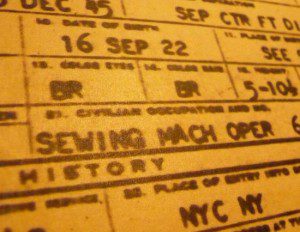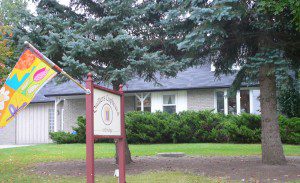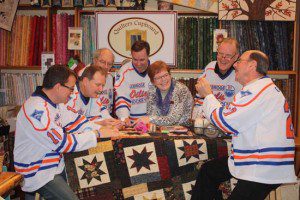
I saw my mother do it. I saw my grandmother do it even more. It wasn’t something my grandfather ever did. And I never saw my father do it. Although, after he died in 2004, we did find some of my father’s military papers from the Second World War when he served a sergeant in the army medical corps. And those papers suggested he knew how to do it. On his Honorable Discharge papers when he left the U.S. Army in December 1945, his attestation revealed that he had done it.
“Civilian occupation,” the discharge papers revealed, “Sewing machine operator.”
So, no, my father wasn’t actually much of a sewing expert the way my mother and grandmother were, but he would certainly have known his way around needles and thread far better than most. Why? Well, over the years, as I have come to know the various occupations of both my maternal and paternal families – after they immigrated from Greece in the early years of the 20th century – I’ve learned among other things they took up sewing in the fur business. That is, they sewed the fur pelts into coats that became the prize possessions of a generation of coat buyers that had no qualms about wearing coats made of mink, fox or lamb skin.
I’ve also learned over the years that both my mother’s mother and my father’s mother were among the most sought after, piecemeal seamstresses in the New York City fur business in the 1930s. In fact, I discovered that Yiayia, my mother’s mother, often faced the wrath of union bosses for taking piecemeal work home with her after hours.
So, the story goes, my father and his siblings were destined to follow in their mother’s footsteps. But Dad probably allowed his hands to operate just one sewing machine when he decided very quickly that he felt more comfortable sitting at a typewriter than at a sewing machine. And he became a reporter. Still, I can’t help thinking that even his passing skill as a sewing machine operator may have served him well as a medic overseas where he constantly had to suture soldiers’ wounds closed. But my father was a doer not a watcher.
“The work only gets done when the seat of the pants is applied to the seat of the chair,” he always said, which applied more to writing than to sewing (but I guess the pants wouldn’t work either if someone didn’t mend the holes and tears in them too).
All of which does not explain why my sewing abilities leave a great deal to be desired. I mean I do remember when I was a Boy Scout I had to sew my various merit badges – for volunteering, birding, camping, climbing, good citizenship, etc. – onto my khaki shirt, but often in desperation I turned to my mother or grandmother to help finish the job. In later years, when my mother and grandmother weren’t around, I’ve learned to sew buttons back onto my shirts and repair holes in my hockey gloves and pants, but only as patch-up jobs.

My closest encounter with true sewing stars occurred back in 2010. That’s when I ventured into the quilting world of my friend Sue Carmichael at her Quilters Cupboard shop in Uxbridge, Ont. She had launched a 30-hour quilting marathon to raise awareness and funds for several cancer-fighting charities. When I visited her shop in the middle of its quilting madness, I had no idea what kind of world I was stepping into.
First, there was the intimidation of the quilts themselves – some simple but elegant, others ornate and dazzling, but all showing the expertise of their brilliant creators. Yes, the quilters themselves seemed even more imposing because they could stitch and talk and stitch and laugh and stitch and teach the less skilled all without batting an eye. However, within seconds of my first visit three years ago, even women carrying sharp objects were no longer a threat.
Further to that point, this past week I made the audacious suggestion to members of my oldtimers hockey team – the Uxbridge Oilies Hockey Club – that maybe we should illustrate just how diverse our talents, how keen our enthusiasm for community effort, and how liberated our sense of men’s and women’s work by helping Sue out with this year’s marathon.

As you can see from the photograph here, the results were far less intimidating than any of my stick-wielding, slap-shooting, and occasionally beer-drinking buddies ever expected. Thanks to the Quilters Cupboard gang, a bunch of hockey players joining the fun and fundraising seemed as natural as ever. And that, Sue and the gals at the shop reminded us, is what quilting is all about.
I think even the U.S. Army bureaucrats who honourably discharged my father, the former “sewing machine operator,” would be proud.